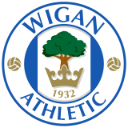
Wigan Sports Football Club has had a number of distinctive and iconic kit designs throughout its history. The club's traditional colors are blue and white, both of which have appeared in their kit designs over the years.
At first, Wigan's kit featured a blue shirt with white shorts and blue socks. The design remained relatively simple until the 1970s when the club introduced more modern elements into the kits.
Throughout the 1970s and 1980s, Wigan's kits saw the introduction of stripes on the jerseys, giving them a unique and recognizable appearance on the pitch. The blue and white striped design became synonymous with Wigan's identity during this period.
In the late 1980s and early 1990s, stripes were replaced by larger blue and white vertical stripes on shirts, creating a bold and striking look. This design choice remains a fan favorite and has become one of the most memorable shirt designs in the club's history.
As Wigan continued to climb the football pyramid and came to the Premier League, their kit designs became more modern and stylish. Vertical stripes still exist but are sometimes supplemented with accents and details, such as colored collars and sleeve hems. One of the most important moments in Wigan's history was during their FA Cup success in the 2012-13 season. In the final against Manchester City, Wigan wore a beautiful black and blue striped shirt, which was enthusiastically cheered by the fans. The unique design added to the feeling when Wigan won a surprise victory in the final.
Over the years, the club's kit sponsors have also featured prominently on the front of the jersey, providing financial support and contributing to the overall design aesthetic.
In recent times, Wigan's kits have continued to evolve with advances in fabric technology, providing players with more comfortable and functional clothing on the field. However, the basic elements of blue and white remain consistent, representing the tradition and identity of the club.
Wigan Athletic's badge, featuring a swan and two roses, is an integral part of the kit's design, symbolizing the club's history and its connection to the region. .
At first, Wigan's kit featured a blue shirt with white shorts and blue socks. The design remained relatively simple until the 1970s when the club introduced more modern elements into the kits.
Throughout the 1970s and 1980s, Wigan's kits saw the introduction of stripes on the jerseys, giving them a unique and recognizable appearance on the pitch. The blue and white striped design became synonymous with Wigan's identity during this period.
In the late 1980s and early 1990s, stripes were replaced by larger blue and white vertical stripes on shirts, creating a bold and striking look. This design choice remains a fan favorite and has become one of the most memorable shirt designs in the club's history.
As Wigan continued to climb the football pyramid and came to the Premier League, their kit designs became more modern and stylish. Vertical stripes still exist but are sometimes supplemented with accents and details, such as colored collars and sleeve hems. One of the most important moments in Wigan's history was during their FA Cup success in the 2012-13 season. In the final against Manchester City, Wigan wore a beautiful black and blue striped shirt, which was enthusiastically cheered by the fans. The unique design added to the feeling when Wigan won a surprise victory in the final.
Over the years, the club's kit sponsors have also featured prominently on the front of the jersey, providing financial support and contributing to the overall design aesthetic.
In recent times, Wigan's kits have continued to evolve with advances in fabric technology, providing players with more comfortable and functional clothing on the field. However, the basic elements of blue and white remain consistent, representing the tradition and identity of the club.
Wigan Athletic's badge, featuring a swan and two roses, is an integral part of the kit's design, symbolizing the club's history and its connection to the region. .

